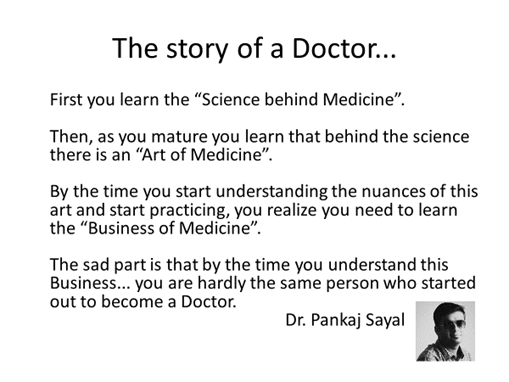On December 31, 2019, when the whole world was getting to welcome 2020, China reported its first case of pneumonia of unknown cause in Wuhan, China, to the WHO Country Office in China. Today we know that it is coronavirus disease (COVID-19), caused by a virus, severe acute respiratory syndrome coronavirus 2 (SARS-CoV-2). This virus has jolted my existence as a physician, a husband, a father, a son, a brother, and as a leader of my group.
Most of my colleagues are my friends. Some of them I have known them for about a decade now, some of them were my first residents, some of them did their first end-of-life discussion with me, and some of them poked a needle for their first procedure with me. Some of them are physicians, some of them I had precepted in their APP schools, some of them are our administrative colleagues who work tirelessly to support our division. It is just heart-wrenching to see us go through this, but at the same time, looking at Italy and New York, it makes me feel guilty and blessed at the same time.
In this unprecedented time, many questions and thoughts have entered my mind about every aspect of life and medicine that have been affected by this virus. How it’s transmitted. How we fight it. How the medicine and life as we know it will be impacted. From the clinical to the emotional to the operational, I break down what I – and I am sure many of you – are thinking about most.
Clinical
Transmission
It is complicated to say what is the mechanism for transmission. There is some evidence to say it is mostly droplet. In a case report published in Annals of Internal Medicine, the authors describe exposure to 41 health care workers from a SARS–CoV-2 positive patient. During an aerosol-generating procedure, eighty-five percent of health care workers were exposed while wearing a surgical mask, and the rest were wearing N95 respirators. None of the health care workers acquired infection. They suggested that surgical masks, hand hygiene, and other standard procedures protected the health care workers from being infected. In addition to symptoms, two nasal PCR tests were also negative.
There is some evidence to suggest, the transmission might be both by droplet as well as airborne. The in-room air samples were 63.2% positive by PCR.
The whole literature is filled with #TWDFNR now. Just because we do it does not make it right. Many countries do not isolate TB patients in negative pressure rooms either or even have the capabilities of doing bronchoscopy in a negative pressure room or do a bronchoscopy at all. COVID-19 will generate a lot of evidence for the next five years, but we would not know how it behaved so differently in different populations. The Curbsiders has just put out a podcast that reviews a lot of these questions too. Practical tips and discussion of what we do and don’t know about COVID-19 transmission, testing, NSAIDs, ACE inhibitors, quarantine, treatment, personal protective equipment (PPE), and more with Paul Sax, MD.
Exposure to SARS–CoV-2
This recent piece in The New Yorker invokes these questions:
- Can we quantify the increase in the risk of infection by exposure to higher doses of the virus?
- Does more exposure result in graver illness?
- Are there quantitative measures of how the virus behaves in infected patients that predict the severity of their illness and how infectious they are to others?
Based on the evidence, we are planning to rotate on the COVID-19 patient population. We will probably measure weekly COVID-19 patient exposure to the physicians and APPs, then rotate them off for a certain time. The strategy might help us just to introduce little exposure and lessen the severity. Yes, this is a “duct-tape” strategy as if the census rises, we are all exposed. We also understand that this might impact us by more colleagues ill or in quarantine, but I guess we will take this risk for less severe disease.
Operational
Business
The Personal Protective Equipment (PPE) shortage is a supply chain and bottleneck issue right now. One of the best books to describe the Theory of Constraints is The Goal by Eliyahu Goldratt. The current bottleneck when it comes to the PPE shortage is melt-blown fiber. Melt-blown fabric is the critical element of the masks, and with that in short supply, cloth-based materials might not work.
I would also like to quote a few lines from one of my physician friends.

After somewhere between two and five years as an attending, we understand the art of medicine, which helps us critically evaluate the science and its application for every patient. Art enables us to have a patient-centered approach. This is not cookbook medicine; instead, it is a merger of value-based and patient-centered care.
Some people like me do go on the “dark side” to understand the business, which unveils that healthcare is a business, and most things are done as a business case. Healthcare is also a combination of a doughnut shop and firefighters. We can probably make the doughnut process lean and just in time, but the firefighter is high variability and high-cost service. We cannot staff the latter at any measure of central tendency. Instead, this is the time to realize hospital medicine groups should staff at 75%-80% of the desired maximum census.
Why Can’t We All Be There To Support NY?
When the health of a country is a free market and not a single body, the resource deployment to the affected areas is like grasping at straws. Wouldn’t it be wonderful if our epidemiologist friends could have predicted the trends based on the daily rate of growth, and we could have deployed all the resources to NY and then next to New Jersey, California, Michigan, and Massachusetts? And when it was our number, the support could come back to us.
The country and its leaders need to understand that food, clothing, shelter, healthcare, and education are a staircase, and one has to climb one before the other. When everything is profit-driven, even the two most basic needs like health and education are driven by money. As a result, the the people use these opportunities to make money. And still, I love democracy, and would not give it up at any cost. In November 1947, Sir Winston Leonard Spencer Churchill once said, “Many forms of government have been tried, and will be tried in this world of sin and woe. No one pretends that democracy is perfect or all-wise. Indeed, it has been said that democracy is the worst form of government except all those other forms that have been tried from time to time.”
Emotional
Trust
It is essential to trust our colleagues in sub-specialties like Infectious Disease and our Local Infection Control group, who are experts in this area and are recommending a specific strategy, which works for the institution. A decade ago, who would have believed that we would not need contact precautions for MRSA. It is important to trust our leaders who are working 24/7 to ensure we have what we need. If not for today, then hopefully for tomorrow.
Philosophy
In these tough times, I find solace in listening to Hans Rosling, a Swedish physician, statistician, and academician. Please watch this short video, in which he describes what 200 countries have achieved in health in the last 200 years in just four minutes. If you have more time, then go into an hour-long documentary or his book Factfulness: Ten Reasons We’re Wrong About the World–and Why Things Are Better Than You Think. I have never mourned a scientist or celebrity more than him. He has always brought positivity in my approach to a problem.
Thankfulness
I am thankful that I chose this profession. I can make a difference. I love being a hospitalist. The word defines me.
I am thankful that I work with colleagues who think and have diverse opinions. It is essential to challenge the norm and trust colleagues.
I am thankful that our division is not getting any salary cuts, layoffs, or furloughs. Many practices are suffering in these times – primarily rural.
I am thankful that all my colleagues and their families are safe and healthy.
There is much to consider about all aspects of this virus and its current and future impact. With that said, I, like you, still have a million questions and very few answers.



What a beautiful article – and so true! We all need to be grateful for the lives we have and health we can maintain. This truly is a puzzle that no doubt we’ll be examining well into the future. Thank you Dr. Chadha.
Awesome! Your leadership shows!!
Thanks for your leadership, Dr Chadha. Glad to be working with you.
Leader good human being like your father
Thank You Dr Chadha for informative blog .. Aptly described .. Stay safe
Informative at this stage of crisis, well done dear Romil……